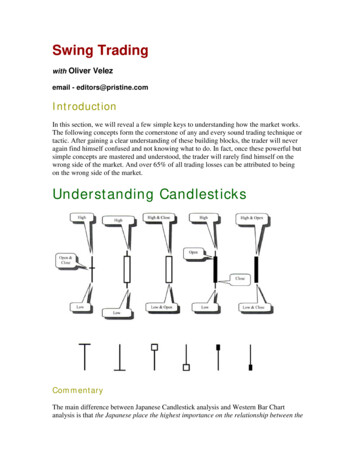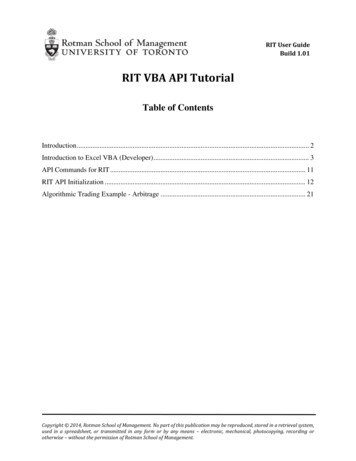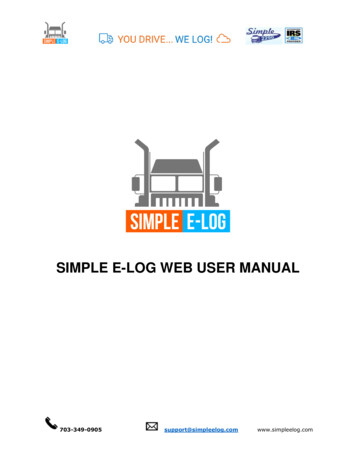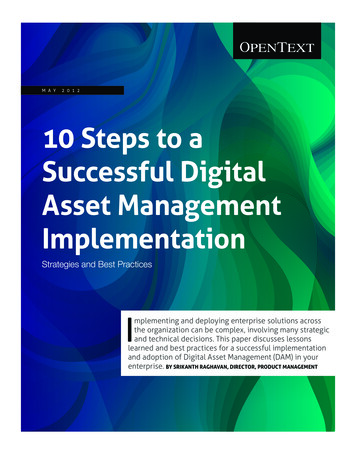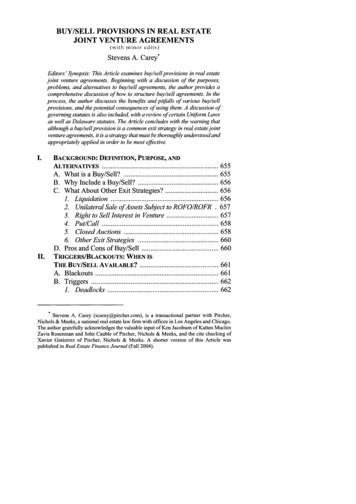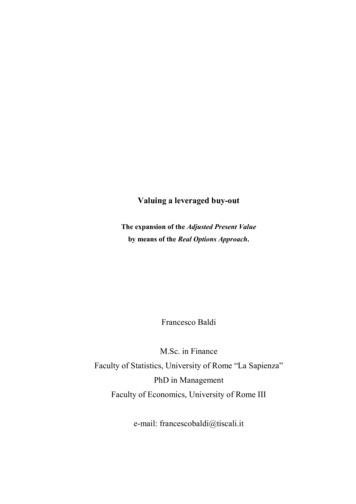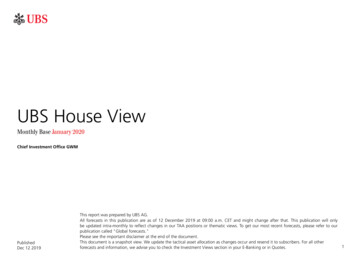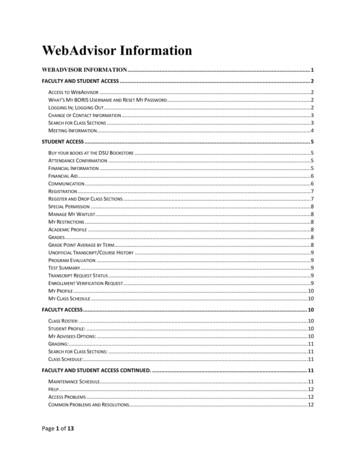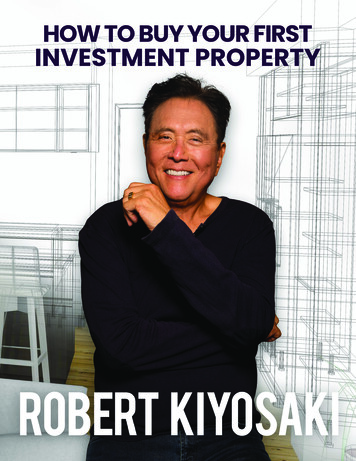
Transcription
HOW TO BUY YOUR FIRSTINVESTMENT PROPERTY
If you purchase this book without a cover, or purchase a jpg or tiff copy of this book, it islikely stolen property or a counterfeit. In that case, neither the authors, the publisher, norany of their employees or agents has received any payment for the copy. Furthermore,counterfeiting is a known avenue of financial support for organized crime and terroristgroups. We urge you to please not purchase any such copy and to report any instance ofsomeone selling such copies to Plata Publishing LLC.This publication is designed to provide competent and reliable information regarding thesubject matter covered. However, it is sold with the understanding that the author andpublisher are not engaged in rendering legal, financial, or other professional advice. Lawsand practices often vary from state to state and country to country and if legal or otherexpert assistance is required, the services of a professional should be sought. The authorand publisher specifically disclaim any liability that is incurred from the use or applicationof the contents of this book.Copyright 2016 by Robert T. Kiyosaki. All rights reserved. Except as permitted under theU.S. Copyright Act of 1976, no part of this publication may be reproduced, distributed, ortransmitted inany form or by any means or stored in a database or retrieval system, without the prior written permission of the publisher.Published by Plata Publishing, LLCCASHFLOW, Rich Dad, B-I Triangle, knowledge: the new money and CASHFLOW Quadrantare registered trademarks of CASHFLOW Technologies, Inc.are registered trademarks ofCASHFLOW Technologies, Inc. Plata Publishing, LLC4330 N. Civic Center PlazaSuite 100Scottsdale, AZ 85251(480) 998-6971Visit our websites: PlataPublishing.com and RichDad.comPrinted in the United States of America042015First Download Edition: November 2013Second Download Edition: August 2014Third Download Edition: April 2015Fourth Download Edition: Feburary 2016
Best-selling Booksby Robert T. KiyosakiRich Dad Poor DadWhat the Rich Teach Their Kids About Money –That the Poor and Middle Class Do NotRich Dad’s CASHFLOW QuadrantGuide to Financial FreedomRich Dad’s Guide to InvestingWhat the Rich Invest in That the Poor and Middle Class Do NotRich Dad’s Rich Kid Smart KidGive Your Child a Financial Head StartRich Dad’s Retire Young Retire RichHow to Get Rich and Stay RichRich Dad’s ProphecyWhy the Biggest Stock Market Crash in History Is Still Coming And How You Can Prepare Yourself and Profit from It!Rich Dad’s Success StoriesReal-Life Success Stories from Real-Life PeopleWho Followed the Rich Dad LessonsRich Dad’s Guide to Becoming RichWithout Cutting Up Your Credit CardsTurn Bad Debt into Good DebtRich Dad’s Who Took My Money?Why Slow Investors Lose and Fast Money Wins!Rich Dad Poor Dad for TeensThe Secrets About Money—That You Don’t Learn In School!Escape the Rat RaceLearn How Money Works and Become a Rich KidRich Dad’s Before You Quit Your JobTen Real-Life Lessons Every Entrepreneur Should KnowAbout Building a Multimillion-Dollar BusinessRich Dad’s Increase Your Financial IQGet Smarter with Your MoneyRobert Kiyosaki’s Conspiracy of the RichThe 8 New Rules of MoneyUnfair AdvantageThe Power of Financial EducationWhy “A” Students Work for “C” StudentsRich Dad’s Guide to Financial Education for ParentsSecond Chancefor Your Money, Your Life and Our World
How to Buy Your First Investment PropertyCONTENTSIntroductionHow Real Estate Builds Wealth.1Chapter OneFinding Properties.2Chapter TwoHow Do I Know a Good Deal from a Bad Deal.8Chapter ThreeDoing the Deal. 13Chapter FourFinding the Deal. 18Chapter FiveClosing the Deal. 21Chapter SixOvercoming the Fear of Failing. 26
HOW TO BUY YOUR FIRST INVESTMENT PROPERTYA LETTER FROMROBERT KIYOSAKIDear Friend,Congratulations and welcome to “How To Buy Your First Investment Property!”Invest for ValueThis ebook is all about Rich Dad’s fundamental formula: look for properties with cashflow AND with a potential for capital gains. People always ask, “What about foreclosures?What about nothing-down deals?” These are certainly valid real estate approaches toinvesting, and we’ll discuss them briefly in this ebook.It’s really about “value investing.” What’s the true value of the property? That valueincludes both cash flow and potential capital gains—and a number of other factors we’llexamine. For now, keep this in mind about the difference between a value investor anda speculator. A value investor buys a property based on its overall value, both today andin the future. A speculator buys with one hope in mind: that the price of the property willincrease.Seek an Area Close to HomeEspecially if you’re a beginner, it’s important to concentrate on an area close tohome—one that you can get to know really well. Drive, walk, or bicycle around that arearegularly. Is it growing or dying? Are there many “For Sale” or “For Rent” signs? Also, findtwo or three brokers who operate in that area. You can find this out simply by seeing whohas the most “For Sale” signs posted. Call these brokers and ask them about the area.What has sold recently and for how much? What do properties rent for, and who rentshere? How long are properties typically on the market before selling?Why do you want to do this? Because when a property comes on the market, you’ll knowvery quickly whether it’s a good deal or not, and you’ll be able to move quickly. In fact, if you1
A LETTER FROM ROBERT KIYOSAKIreally get to know an area well, you may even hear about a new property before it comes onthe market and get a real jump on the competition.My wife, Kim’s, first real estate investment was in an area close enough to our homethat we could jog there. She’d walk, run or drive through the area at least three times aweek to pick up any changes happening in the neighborhood.Start SmallI can’t emphasize this enough—when you’re starting out, start small.Invest a lot of time and a little moneyin your first deal. Most people do justthe opposite—they invest very littletime and a lot of money and wonderwhy they lose! You want to keepyour risk small, because you’re on alearning curve. Why risk a lot whenyou know there’s a lot to learn?“The difference betweenrich people and poorpeople is which waytheir cash is flowing.”Expect to Make MistakesYou’re bound to make mistakes—everybody does! Just remember thatmistakes aren’t setbacks: they’rereally forward steps in the learningprocess. The fact that mistakeshappen is one reason that positivecash flow is important right from thestart, because it can help buffer thosemistakes.For example, two friendsrecently purchased their firstinvestment property—a 4-plex.Within a month of taking ownership,2the city issued a citation that demanded theypave their driveway. They were able to pay forthis unexpected expense out of their cash flow.This meant that their property paid for theireducation, not themselves personally.Know What You Can AffordFirst of all, this means finding out how muchit’s going to cost you for the amount of cashflow you want. In other words, what will it costyou to get 15%, 20%, or 30% return on your cashinvestment? You’ll learn how to figure this out inthe workbook, but you’ll also need to know thespecifics for your own area.
HOW TO BUY YOUR FIRST INVESTMENT PROPERTYSecondly, remember that your primary investment goal is to improve your personalfinancial statement.So ask yourself these questions about a potential purchase: If the tenant moves out and the property sits vacant, how long can I afford it? If there’s a costly maintenance problem, can I afford it? This is another reasonto start small. If my friends with the 4-plex had started with a 12-unit apartmentbuilding, that driveway would have cost them much more and would probably havecaused them a much bigger financial problem.Remember, the purpose of real estate investing is to solve your financial problems, notgive yourself bigger ones.Look for Properties with ProblemsIt’s really true: One of the best things to look for is a property that someone else haswalked away from because of a problem. Figure out how to fix that problem, and you caninstantly increase the value of that property.One of my favorite examples is when my wife, Kim, and I came across an apartmentbuilding in Phoenix, Arizona, with a 37% vacancy rate—a pretty high number. Nobody elsewould touch it. But we asked ourselves the following question: “How can we solve thisproblem?” It turned out the property was being run as a hotel: People could rent a fullyfurnished apartment for anywhere from a week to a year. One not-so-small problem—noone wants to be in Phoenix in the summer, so most of the units sat vacant during thosemonths. To make a long story short, we did our research and converted the property fromshort-term hotel rentals to regular long-term rental apartments. The vacancy rate wentfrom 37% to 3%—and the property’s value soared. We were winning on both cash flowand capital gains!Your job as a real estate investor is to seek out propertieswith problems—and solve them.Always Remember to Look at the Numbers3
A LETTER FROM ROBERT KIYOSAKIAs Rich Dad often said, “Think with your calculator, not your heart.” So once youunderstand the area you’ve chosen to invest in and you know what it is you’re looking for,be sure to follow through by looking closely at the numbers on your chosen properties.The numbers will almost always tell you whether you’ve found a good deal. The workbookhas lots of valuable information about analyzing the numbers.One Final Word of AdviceRemember that price isn’t everything, so don’t be led away from your principles bywhat seems an attractively low price.Does the property meet your criteria? Does it have positive cash flow? Is there a goodchance of appreciation? Rich Dad said it best: “Just because a property is cheap doesn’tmean it’s a good deal. In fact, if it’s cheap but has no value, it could be the most expensiveproperty you can buy.”Remember Rich Dad’s fundamental formula: Look for properties with cash flow ANDwith a potential for capital gains. Okay, now it’s time to really get started. Get ready tobegin your successful journey to Investing in Real Estate!Thank you and all the best,Robert Kiyosaki4
HOW TO BUY YOUR FIRST INVESTMENT PROPERTYIntroductionHOW REAL ESTATEBUILDS WEALTHReal estate investments offer both tax advantages and the advantage of appreciation,the tendency of a property to increase in value over time. But the biggest advantage isleverage—using other people’s money (OPM) to purchase an investment worth manytimes what it costs you to buy. Using OPM in the form of a loan, you can buy a propertythat generates passive income for you even though you’ve invested very little.What Are My Choices?You can build wealth through real estate in several different ways. Below are what thosechoices are—and which ones Rich Dad recommends.1. Cash flow or capital gains?Long-term cash flow, with the potential for future capital gains. Cash flowassumes you’re going to hold on to a property to reap the benefits of ongoing passiveincome; capital gains result from selling a property at a higher price than the price atwhich you bought it. Some investors buy a property only to turn around and sell it forthe capital gains. Both cash flow and capital gains are good ways of realizing profitsfrom your real estate investment and both have a place in an investor’s real estateportfolio. But for the investor who wants to realize the goal of financial freedom byliving off passive income, cash flow is definitely Rich Dad’s way to go.2. Buy and hold or buy and flip?Buy and hold. This is a tried-and-true way to become infinitely wealthy. If you buy well,hold on to the property, and manage it wisely, buying and holding can provide a good,steady passive income every month. Plus, if the property appreciates in value over time,it not only gives you a monthly stream of cash flow but also still allows you to realizecapital gains if you sell. On top of that, your tenants pay off your loan! Buying andflipping can also be a good practice because sometimes you don’t even have to put anyof your own money down in order to make a profit on the property. But remember, you5
INTRODUCTIONthen have to get that profit working again to create cash flow. Please consult your taxaccountant for the best investment strategy for you.3. No money down or money down?Remember the magic words—cash flow. It’s really a balancing act. You want thegreatest return on your money and you want to leverage your money well. Forexample, if you’re just starting out and only have a small amount of money to invest,then the most highly leveraged investment (the least money down) that still gives youpositive cash flow may be best for you at that time. If you have a large sum of moneyto invest, you still want to leverage your money effectively, but you may be willing toput down more money in order to get a healthier monthly cash flow on yourinvestment. It all depends upon your personal investment plan.Definitionsyou’ll need to knowFixer-upper A property that needs renovation.FSBO For Sale by Owner—a property being sold by its owner without a real estate professional’sservices.Vacancy rate A figure representing the annual percentage of units unrented or the percentage of time asingle unit remains unrented during the year.Zoning laws Regulations governing land use, population density, and building size and use. Set by localgovernments, zoning laws typically change as communitiesdevelop; you can also request changes or exemptions.6
HOW TO BUY YOUR FIRST INVESTMENT PROPERTYChapter 1FINDING PROPERTIESWhere Do I Begin?Now you’re ready to start looking for properties. But what exactly are you looking for? Andwhere do you find it? In this chapter, you’ll learn how to answer those questions for yourself just as rich dad would.First, you’ll learn how to figure out what types of property fit your plan. You’ll learn rich dad’smost important guidelines that apply to any situation, but you’ll also learn how to set othercriteria based on your own particular circumstances and goals.Then you’ll get some very practical advice on where to find those properties you’vetargeted. You’ll walk through some basic tips & methods to find properties.Along the way, keep in mind thatcardinal 100-10-3-1 rule. For everysingle property you end up buying, youshould expect to:Look at 100Make offers on 10Have 3 acceptedBuy 1At the end of this chapter, you’ll take abig step toward buying that first realestate investment—you’ll start yourfirst list of 100 properties!“Every man whoinvests in well-selectedreal estate in a growingsection of a prosperouscommunity adopts thesurest method ofbecoming independent,for real estate is thebasis of wealth.”—Theodore Roosevelt7
CHAPTER 1 FINDING PROPERTIESWhat am I Looking For? Establishing Your CriteriaTwo of the most important things to keep in mind about properties are cash flow andappreciation. No matter what your level of experience, these should always be your twoprimary criteria.Keep your eyes peeled for areas that are up-and-coming. Real estate in generaltends to appreciate over time, but you want to find areas that are appreciating evenmore. A good idea is to look not just at the residential area, but nearby commercial areas aswell. Are there new or high-end stores opening in the area? Are there new office buildingsbeing built or companies moving in? These could be signs that the neighborhood isimproving or in demand, and you may be able to get in on the ground floor of a boomingmarket. Read the following questions and answers, then fill in the Basic Criteriaworksheet.What Type of Property is Right for Me?Start small Start with a small property—a single family home, a duplex, or 3-plex. Mistakes are part of the process, and you should expect to make them. With eachmistake, you become smarter and your next investment easier. So make your mistakeson small properties, learn from the mistakes, then move on to larger properties. This isalso why you want positive cash flow properties: The cash flow can buffer the mistakesyou’ll make along the way.Stay close to home Ideally, look for rental properties that are near where you live.That makes it easy to drive around the neighborhood and see what new properties areon the market, watch the selling prices and purchase prices, talk with the neighbors, andkeep a pulse on your particular market.Establish cash flow as soon as possible Your goal is positive cash flow, ideallyfrom day one. Sometimes you’ll need to take a few steps before the cash startsflowing, but make positive cash flow your top priority.Hold on to the property as long as it produces a reasonable income streamOr hold on until it appreciates and you can sell it, moving the gain to a larger propertywith an even stronger cash flow. As far as rich dad is concerned, the best investmentsare those that keep the cash flowing year after year.8
HOW TO BUY YOUR FIRST INVESTMENT PROPERTYSo What Types of Property Can Help Me Meet These Goals?If you’re a beginner, you’ll want to look primarily for residential real estate up to about a3-plex at most. If you’ve already begun investing and are ready to increase your holdings,it might be time to move on to 4-plexes or maybe even a small apartment building. As youbecome more confident in your plan, you’ll quickly graduate to larger properties.MY REAL ESTATE CRITERIAI am looking fortype of property.I plan to invest about My price range is as a down payment.- (Multiply down payment by 10, then subract 20% to 30% for the low end, and add 20% to 30% for the high end of your range.)I plan to invest about for renovations and fixing up.I am considering the following types of financing:How Much Can I Afford?First, decide how much you have available as a down payment. For a rough estimate ofprice range, multiply this by 10, which assumes putting 10% down. You may very wellultimately put more or less than 10% down, but it’s a good way to estimate your target. Nowcalculate 20% to 30% above and below that target to establish your range.Rich dad said: “When buying investment properties, look forcash-flow potential and areas that are up-and-coming.”9
CHAPTER 1 FINDING PROPERTIESNote: Don’t limit yourself exclusively because of price. Never turn a good investment downbecause “I can’t afford it.” You’ll be amazed at how creative you’ll become about finding themoney if the deal is very good. Not having the money often makes you smarter because youhave to think of alternative ways to come up with what you need.How Much of A “Fixer-Upper” Can I Tolerate?To find a good bargain, learn to see beyond the obvious. Sometimes properties in obviousneed of work can become wonderful opportunities—if the price is right, that is. However,when you first start out in real estate investing, you may not have the time, or the up-frontfunds, to take on major renovations. What you’re looking for are properties that needsmall, inexpensive, cosmetic fixes: yard clean-up, decorative painting, a new refrigerator.Sometimes a small investment—less then 1,000—can add significantly to the potentialvalue and rental rate of a property. Also, consider the age of the property when thinkingabout renovations. Often, older properties need more work.How Will I Pay for This Property?It’s not too soon to start thinking about how you’ll finance this investment. For now youjust need to start considering potential sources of funds.Take note of the following financing sources: Local banks, mortgage companies, and savings and loans.Private funds.Assumable mortgages.Owner financing.Where Do I Look? Finding Properties and BargainsEspecially when you’re starting out in real estate, there’s just no substitute for going out andlooking at properties. It’s the best way to get a realistic feel for the market you’re entering andto spot trends you might be able to take advantage of. It’s also a good way to find a broker. Asyou look at For Sale signs, take note of the broker names that appear most frequently—they’llknow the most about the area you’re interested in. Start with your own neighborhood or oneclose by, so you can go there again and again. As you start your search, keep the followingtips in mind. They’ll help you narrow your focus.10
HOW TO BUY YOUR FIRST INVESTMENT PROPERTYExplore the AreaIt’s important that you personally inspect the area. Jog, walk, or drive around theneighborhoods you’re considering regularly. Note any changes, and pay particularattention to For Sale signs. How fast do they go up—and come down? Who are the mostpopular agents? Talk to people who live in the area and ask them about it. You might besurprised at the answers.Scan the InternetThere are hundreds of sites full of real estate deals. Compare the price ranges and rentalrates in different neighborhoods. This comparison will help you identify an area orneighborhood that shows promise.Talk to Real Estate ProfessionalsOnce you’ve identified a market, make appointments with several real estateprofessionals who do business in the area and discuss the market with them. They notonly know what’s available, they can also give you a good idea on price and currentmarket conditions.Talk to the Local Chamber of CommerceAll chambers of commerce produce studies that provide information on planned futuredevelopments, both public and private. This information can be valuable when looking atthe potential growth and change in a neighborhood.Identify Useful Governmental Agencies and OfficialsGovernmental bureaucratic red tape can be maddening, but you do need to knowsomething about the laws affecting the rental market in your chosen area and the realestate laws in general. Take the time to find out which state and local governmentalagencies regulate the real estate and housing industries in your area. Always consult alawyer if you have doubts or questions.Seek Out Local Real Estate Investment Clubs and AssociationsResearch Zoning LawsContact your local zoning and planning commission. They can provide you with the mostup-to-date information on current and future plans for the area in which you wish toinvest.11
CHAPTER 2 HOW TO KNOW A GOOD DEAL FROM A BAD DEALChapter 2HOW DO I KNOW A GOOD DEALFROM A BAD DEALAs you look at properties, you’ll be forming opinions based on what you see. But to pickout the good deals from the not so good, you also need to look deeper. You need to lookat the numbers.In this chapter, you’ll learn how to review a pro forma—a good tool for evaluatingproperties in terms of the return they might generate on your investment. You’ll look atseveral examples and learn how to get a better fix on a property’s potential bycompleting an upside checklist. And to prevent “analysis paralysis,” you’ll also learn abouttaking shortcuts to a deal. By the end of this chapter, you might be well on your way toyour first successful deal!What is a Pro Forma?A pro forma is a type of financial statement for an investment property. But unlike a cashflow statement representing current income and expenses, a pro forma is a projection ofanticipated income and expenses. Most pro formas don’t show actual operatingnumbers.Where do you get pro formas? Ask the agent, whose job it is to gather the information ona pro forma in order to market the property to potential buyers. You can even ask a realestate broker for pro formas for the general types of property you’re interested in. You’llsoon see that they come in all shapes and sizes, but if you understand the basicelements, you’ll always be able to get to the information you need.Remember, pro formas are selling tools, and they typically paint a rosy picture. They mayassume an increase in rents, as well as decreases in the vacancy rate and in expenses.On the next three pages we will discuss the components of a pro forma, look at a samplepro forma, and analyze it.12
HOW TO BUY YOUR FIRST INVESTMENT PROPERTYWhat’s on a Pro Forma?The definitions that follow will help you understand the information on just about anypro forma. Real estate brokers typically don’t generate pro formas for single family rentalproperties. But as you’ll see in the following example you can easily use the same formatfor any type of investment property—even a single family home.The NumbersThe numbers on a pro forma will tell you whether a property qualifies for further review. Ifyou decide to pursue the property you will then use the pro forma numbers as a startingpoint for the financial analysis you will do with Rich Dad’s Real Estate Evaluator .Rich dad said, “You can’t tell from the building alone whetheran investment is good or bad. You’ve got to look at thenumbers. The numbers tell the story.”What Do All the Terms Mean?Many of the individual items on a pro forma are self-explanatory. A few are defined morethoroughly below.Price Either the seller’s asking price, or what you expect the purchase price to be.Cash on Cash Return The annual cash flow divided by the down payment assumed by the seller. On a pro forma this is simply an indicator.CAP Rate (capitalization rate) The net operating income divided by the purchaseprice, expressed as a percentage. The CAP rate, which excludes the amount of debt,is an indicator of the value of the property.Unit Mix The number of units on a property. Unit type includes studio, 1 bedroom1 bath, 2 bedroom 1 bath, and so on. From the figures for number of units, squarefootage per unit, and monthly rent, you can calculate the rent per square foot andthe total monthly income from all the units of each type.13
CHAPTER 2 HOW TO KNOW A GOOD DEAL FROM A BAD DEALGross Income The total of all income from all units whether actually rented or not.Vacancy Rate The percentage of rent you will not collect because of unrented units. Ifyour gross income is 1,000 and your vacancy rate is 10%, you’ll subtract 100 fromthe income.Other Income Other sources of income such as parking fees, laundry service, etc.Operating Expenses All the expenses of operating the property.Reserves Money set aside for repairs and improvements to a property.Net Operating Income (NOI) The total operating income less total expenses.Debt Service The amount of principal and interest, based on the financing proposed on the pro forma.Cash Flow What’s left over after all cash expenses—including the mortgage principal and interest payment—have been made.Assumable or Owner Financing Either the amount and terms of a loan that thebuyer can take over or the amount of debt the seller is willing to carry, which meansyou’ll be borrowing money from the seller at an agreed-upon interest rate.14
HOW TO BUY YOUR FIRST INVESTMENT PROPERTY15
CHAPTER 2 HOW TO KNOW A GOOD DEAL FROM A BAD DEALHow Do I Analyze the Pro Forma?Now that we’ve defined several of the terms on a pro forma, let’s take the nextstep—interpreting the information on the pro forma to determine whether the property isa potential investment for you. After you’ve reviewed many pro formas, the process willbecome much easier as certain properties will be quickly eliminated and others will standout as potential winners. Your skills as a real estate investor improve with every propertyyou analyze.Location A property’s location can help determine if the price is a good deal.Upscale neighborhoods will naturally carry a higher price tag, but remember to thinkin relative terms, and look especially for prices that may be lower than the averagefor the area. Also, is the neighborhood up-and-coming or deteriorating?Price per unit, price per square foot For multiple unit properties, these are goodfigures to look at for comparisons. You might find a property with a high price perunit (price divided by number of units), but if the units are larger than average, withgreater square footage, the price per square foot might be competitive. As youbecome more familiar with a given area, these figures will become key indicators.Unit mix Look for a mix of unit types that matches the needs of the area. Studiosmight do well in a college town, but two bedroom apartments might be a biggerdraw in a downtown location.Age of the property The older the property, the greater the likelihood that you’llbe facing deferred maintenance—in which case you might want to increase thereserves you set aside for repairs.Vacancy rate Always assume some sort of vacancy rate; ask your broker whatthe average is in the area. A high vacancy rate may actually represent anopportunity: It can justify asking for a lower price, and if you can see ways to turnthe situation around, you can greatly increase the value of the property and thecash flow to you.16
HOW TO BUY YOUR FIRST INVESTMENT PROPERTYExpenses This is where some knowledge and experience can improve yourbottom line. A poorly managed property will reveal itself in high expenses. Forexample, a high electricity bill may mean that the owner pays for the tenants’electricity; you might be able to improve cash flow by having the tenants pay fortheir own electricity. Note that in the preceding examp
Rich Dad Poor Dad . Rich Dad s CASHFLOW Quadrant Guide to Financial Freedom Rich Dad s Guide to Investing What the Rich Invest in That the Poor and Middle Class Do Not Rich Dad s Rich Kid Smart Kid Give Your Child a Financial Head Start Rich Dad s Retire Young Retire Rich
